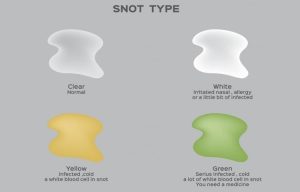
Mucus is a slimy substance secreted by mucous membranes that lines the organs and cavities of our body. The major structural component is mucin which is a complex glycoprotein and is capable of forming gels. What is mucus and mucus color, these gels have a polyelectrolyte effect on the mucus which regulates the influx and efflux of water in it. Functionally, mucus has protective and lubricating effects. It not only protects the linings of respiratory system but also protects linings of the urinogenital and gastrointestinal systems. In the respiratory system, it acts as a barrier by trapping bacteria and other pathogens that might gain entry otherwise and cause damage to the lungs.
What is mucus and mucus color – What does it mean?
Dr. Virendra Singh says. Mucus in the respiratory tract is secreted in the nose, throat, and lungs. Dr. Virendra is considered as a pioneer in the field of respiratory medicine and is a leading asthma specialist of our country. Caring & treating difficult asthmatic patients is his passion.
Mucus from our nose:
It looks unendurable and unimportant when there is an excessive or extra secretion of mucus from our body but it is necessary to prevent entry of pathogens or to prevent more damage. When the insides are inflamed such as sinuses, it takes more time to get complete rid of that extra produced mucus in our body. More production of mucus can be a sign of multiple things like bacterial infection, cold or dried cells and inflammation. The color of mucus indicates the possible cause of the produced mucus. Our body defends itself through different mechanisms failing which it catches any infection. “During any infection both production and elasticity of mucus increase”, says Dr. Virendra.
Colors of nasal mucus:
Color of nasal mucus indicates different conditions of your body. Different pathogens and substances try to gain entry into your respiratory system, but mucus is there to line the tract and protect us from such harmful alien substances that might infect your body. Colors can be clear, white, yellow, green, pink, brown and black depending upon the type of infection or allergy.
(i) Clear mucus:
Usually, if your mucus is clear, you are free from any sort of infections. Our body produces mucus daily, most of which we swallow. The composition of such mucus includes proteins, salts, and antibodies. However, allergies may also cause increased discharge of mucus.
(ii) White mucus:
Congestion experienced due to inflammation and swelling in the nose may cause blockage in the flow of mucus. Swollen nose and inflamed tissues causing a slow flow of mucus make mucus lose its moisture, making it thick and cloudy. Such type of mucus indicates cold.
(iii) Yellow mucus:
It is an indication of infection beholding your body and staying for long. Yellow color is due to the white blood cells which are fighting back and producing such a response.
(iv) Green mucus:
Such mucus is due to thick white blood cells, i.e., your immune system is fighting back. It could possibly be due to bacterial infection or sinusitis.
(v) Pink or red mucus:
This could be due to broken nasal tissues coming out along with the mucus. Nasal tissues break to blowing out the nose a lot or rubbing it frequently.
(vi) Brown mucus:
Brown color in mucus is due to old blood or something inhaled such as dirt, snuff or paprika.
(vii) Black mucus:
Dr. Virendra Singh says, if you are inhaling too much smoke, dirt or debris at the workplace, color of mucus becomes black. Also, fungal infections make color of mucus turn black. Mucus, therefore, traps different types of antigens or pathogens. The amount of mucus that we swallow takes everything along into the stomach where the antigens are taken care of. It is thus, an important defence barrier.




